Learn how to make sushi rice perfectly every time with step-by-step pictures and a video tutorial. All you need are simple ingredients such as rice vinegar, sugar, salt, and kombu. Once you master the secret of making the sushi rice, you will be ready to dish up all kinds of mouth-watering sushi recipes!
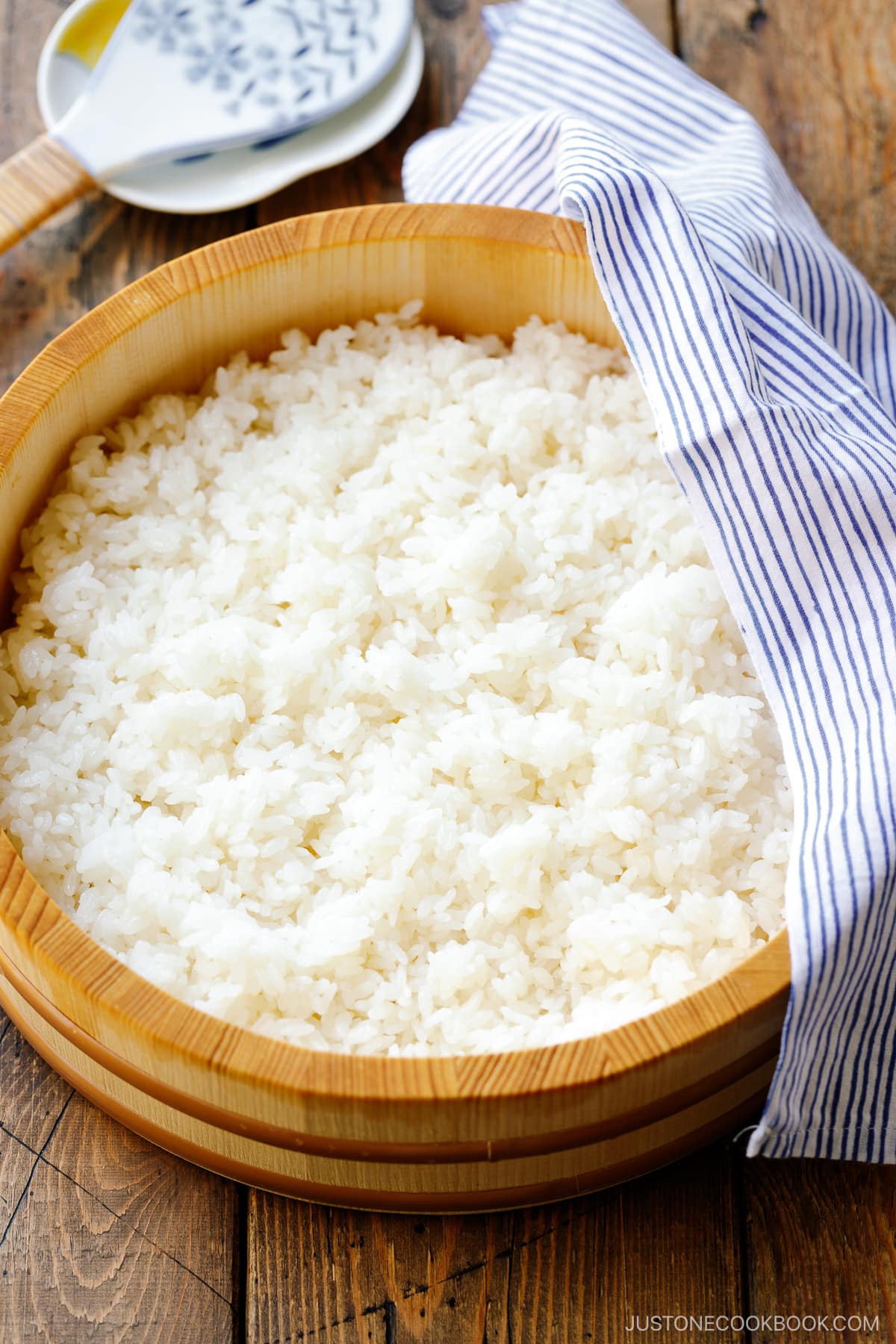
Perfectly cooked Sushi Rice (酢飯) is fundamental in making any form of sushi. Indeed, the best sushi restaurants in Japan pride themselves not only on the freshest fish or variety but on the technique and quality of the sushi rice. Here, I shared my secrets and techniques on how to make sushi rice the authentic way. Follow along, and you’ll be able to make the best sushi rice at home for all kinds of sushi!


What is Sushi Rice?
Sushi rice is made by cooking Japanese short-grain rice with kombu (kelp), which is then seasoned with a mixture of rice vinegar, sugar, and salt. In Japanese, sushi rice is also known as sushi-meshi (鮨飯), su-meshi (酢飯), or shari (シャリ). We only use this vinegar-flavored rice when making all kinds of sushi.

It’s worth noting that outside of Japan, Japanese short-grain rice is often called “sushi rice” for marketing purposes. In reality, Japanese rice is typically used in everyday meals and less often in sushi recipes.
You may also notice that Japanese short-grain rice has been incorrectly called “sticky rice.” Sticky rice is actually another name for glutinous rice or short-grain Japanese mochigome. We use this type of glutinous rice to make Mochi, Sekihan, and Okowa.
👉🏼 If you are here looking for a recipe to make plain steamed rice, see my post on How to Make Rice.
👉🏼 To brush up on your knowledge, I highly recommend reading “Everything You Need to Know about Japanese Rice” and “Types of Japanese Rice.“
Why Do We Season the Steamed Rice with Vinegar?
This actually goes back to the origin of sushi. The literal meaning of sushi is “sour flavor.” Historically, the way people stored fish was by wrapping it in fermented rice. When they were ready to enjoy the fish, the fermented rice was tossed away.
Sometime between the 1300s and 1500s, the Japanese slowly stopped using fermented rice and instead added vinegar to the rice to further increase its shelf life. The vinegar ended up improving the flavor of the rice so they started eating the fish and the rice together, which evolved to today’s sushi.
These days with refrigeration, there is no longer a spoilage issue with the fish, but the centuries of flavoring the rice with vinegar have become the mainstay.

Where to Buy Japanese Short-Grain Rice
You can find Japanese short-grain rice, commonly labeled as sushi rice, in major grocery stores these days. Some standard, affordable brands like Kokuho Rose and Nishiki are medium-grain rice.
For premium brands, I recommend Tamaki Gold and Tamanishiki Super Premium Short Grain Rice, which are available in Asian grocery stores.

If you’re looking for imported, high-quality rice from Japan, I would recommend the Koshihikari variety, which is available from various brands at Japanese grocery stores. Known for its sweet taste and fragrance, it is the most popular variety in Japan.
My family and I like the Koshihikari rice from Toyama prefecture (see above). Nijiya Market sells it and we think it’s one of the best imported rice available here in the U.S. at this time.
The Right Rice-to-Water Ratio

When cooking rice normally, the Japanese golden ratio for white rice to water is 1 to 1.1 (or 1.2).
However, when making sushi rice (for all kinds of sushi recipes), it is very important to leave room for the sushi vinegar to soak into the cooked rice. For that reason, the amount of water to cook the short-grain rice is slightly moderated.
To make sushi rice, the golden ratio for white rice to water is 1 to 1.
Also, The rice should be cooked slightly harder and the steaming time should be shortened.

How to Make Perfect Sushi Rice
The Ingredients You’ll Need
- Japanese short-grain rice
- Kombu (kelp) – optional, but it infuses your rice with a nice aroma
- Rice vinegar
- Sugar
- Salt
The Cooking Steps
- Cook rice with kombu using your preferred cooking method.
- Make “sushi vinegar” seasoning.
- Transfer cooked rice to a baking sheet lined with parchment paper or a sushi oke or hangiri (traditional method).
- Season the rice with “sushi vinegar.” Then, fluff the rice with a rice paddle using a slicing motion.
- Cover with a damp towel and ready to use.


Cooking Tips
- Use Japanese short-grain rice. To achieve an authentic Japanese standard, you want to use only short-grain Japanese rice to make sushi rice. This is because the consistency and flavor of Japanese rice are very different from long-grain rice, jasmine rice, or other types of rice. With a higher content of moisture, Japanese rice is characterized by its unique stickiness and texture, which is attributed to the toothsome bite of authentic sushi. Read more about rice on my pantry page.
- Rinse and soak the rice before cooking. Make sure the rice is washed and rinsed a few times until no more starch comes out from the water. Then let the rice be soaked for at least 20-30 minutes before cooking. This allows the rice grains to yield a better texture.
- Cook the rice with kombu. Kombu (dried kelp) gives a subtle fragrance and umami taste to the sushi rice.
- The rice-to-water ratio is 1:1 (volume). Because we add sushi vinegar to the cooked rice, we use a bit less water than when you cook the rice regularly.
- Make homemade sushi vinegar. Sushi rice is always seasoned with sushi vinegar. It’s made of rice vinegar, sugar, and salt to achieve a balance of sweet, salty, and sour taste. You need to get mild-flavored rice vinegar, not another type of vinegar for this; otherwise, it’s too strong and the flavor is not the same. If you want to save time, you can use a bottle of seasoned vinegar called sushizu (すし酢).
- Transfer cooked rice to a sushi oke (hangiri), a large salad bowl, or a baking sheet lined with parchment paper. You must let the rice cool fast. It’s common to use an electric fan or hand-held fan called uchiwa (うちわ) to cool the rice.
- Add sushi vinegar when the rice is hot. As soon as the rice is taken out of the rice cooker or the cooking pot, you have to season the rice with sushi vinegar.
- Fluff the rice in a slicing motion with a rice paddle. Don’t mix or else sushi rice will end up being mushy or smashed. With proper fanning and slicing, your sushi rice becomes shiny!
- Cover with a damp towel and keep it at room temp until you’re ready to make sushi.

What Does Perfectly Cooked Rice Look Like?
After the rice is steamed, the rice should be shiny and plump. The texture should be fluffy with a firm bite. And each rice grain should be sticky yet retain its shape. Mushy rice means it has too much water or it is overcooked. If the rice is fresh, you will see a nice shiny gloss on the surface of each grain.
Sushi Oke (Hangiri) – A Wooden Tub
The wooden tub that is used to season, mix, and cool sushi rice is called sushi oke (寿司桶) or hangiri (はんぎり). It has straight edges and a flat bottom, which assists in spreading hot rice and allowing it to cool after adding sushi seasoning. The Hinoki cypress absorbs excess moisture.
 I have a 17-inch (great for a big party), a 14-inch (4-6 servings), and a 10-inch (2-3 servings) sushi oke.
I have a 17-inch (great for a big party), a 14-inch (4-6 servings), and a 10-inch (2-3 servings) sushi oke.Best Way to Store Cooked Rice
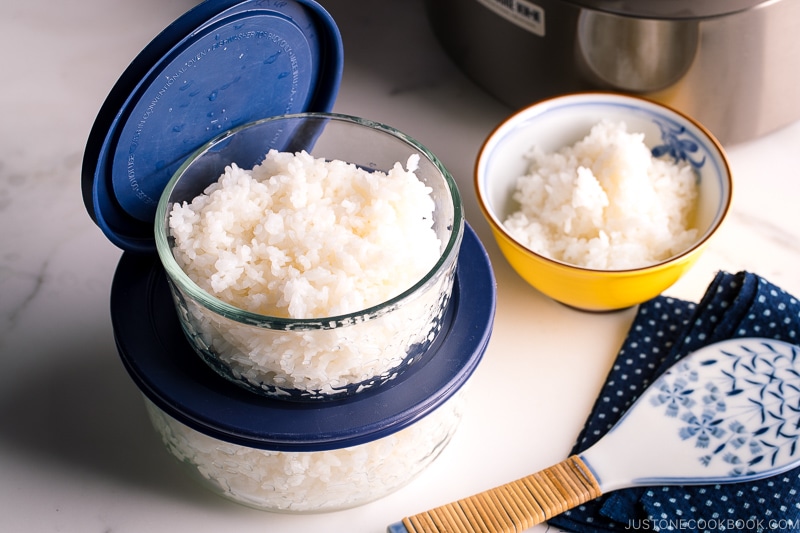 How to Store Cooked Rice
How to Store Cooked RiceWhat’s the best method to store cooked sushi rice? Simply freeze the sushi rice in airtight containers and bring it back to room temperature when you need it to make sushi! This is by far the best approach to keeping your sushi rice fresh and moist. Do not refrigerate it!
Other Methods of Cooking Japanese Rice
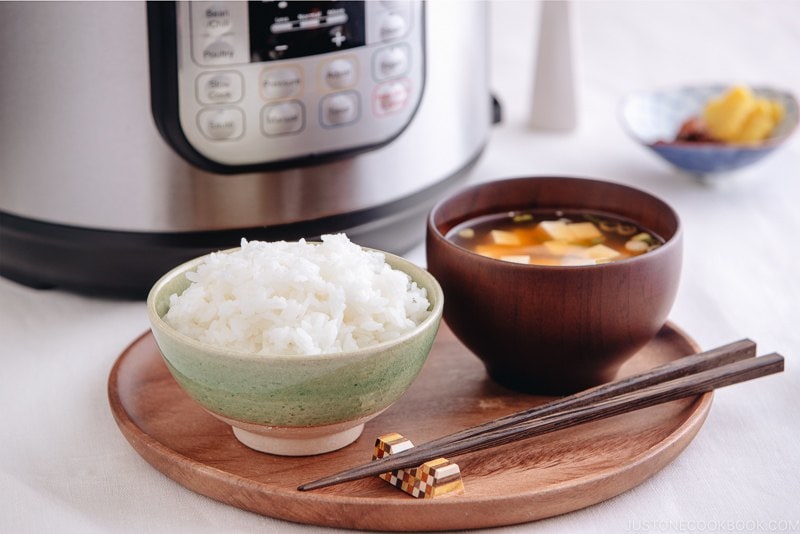

You can cook the rice using a pot over the stove, but the most convenient way is to cook sushi rice using an electric rice cooker. In my Japanese home kitchen, my trusted rice cooker brand is Zojirushi Rice Cooker. Because I cook sushi rice often, this rice cooker has a ‘sushi’ option, which makes it really easy to ensure the rice is cooked perfectly. Here are my recipes for different cooking options.
- How to Cook Rice in a Rice Cooker
- How to Cook Rice in a Pot over the Stovetop
- How to Cook Rice in an Instant Pot
- How to Cook Rice in a Donabe
Delicious Sushi Recipes


Now with perfectly cooked sushi rice, you can make all kinds of sushi recipes! If you are interested in learning more, check out my post Learning at Sushi Skills Seminar in San Francisco.
- California Roll
- Dragon Roll
- Spicy Tuna Roll
- Yellowtail Tuna Roll (Negihama Maki)
- Hosomaki (Thin Sushi Roll)
- Futomaki (Thick Sushi Roll)
- Chirashi Sushi
- Saba Oshizushi (Mackerel Pressed Sushi)
- Inari Sushi
- Temaki Sushi (Hand Roll)
- Temari Sushi
- Mosaic Sushi
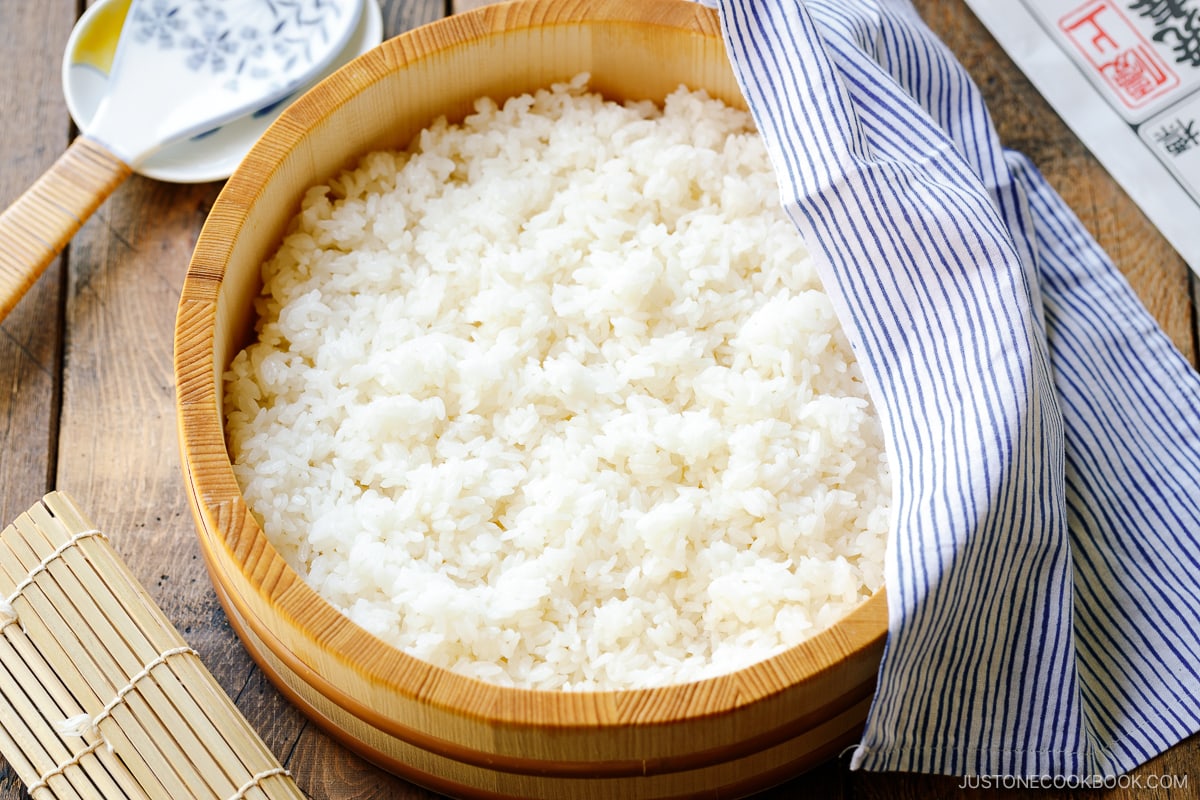
Wish to learn more about Japanese cooking? Sign up for our free newsletter to receive cooking tips & recipe updates! And stay in touch with me on Facebook, Pinterest, YouTube, and Instagram.

Prep Time: 10 minutes
Cook Time: 1 hour
Soaking Rice Time: 20 minutes
Total Time: 1 hour 30 minutes
Japanese Ingredient Substitution: If you want substitutes for Japanese condiments and ingredients, click here.
Before You Start…
How much rice to cook depends on the kind of sushi you make. One thick sushi roll (futomaki) requires 1⅔ cups (250 g) of sushi rice. One medium sushi roll (chumaki) like Vegetarian Sushi Roll requires 1 cup (150 g) of sushi rice. One thin sushi roll (hosomaki) requires ½ cup (80 g) of sushi rice. One inside-out sushi roll (uramaki) like California Roll requires ¾ cup (110 g) sushi rice. One nigiri sushi requires 20 g of sushi rice.
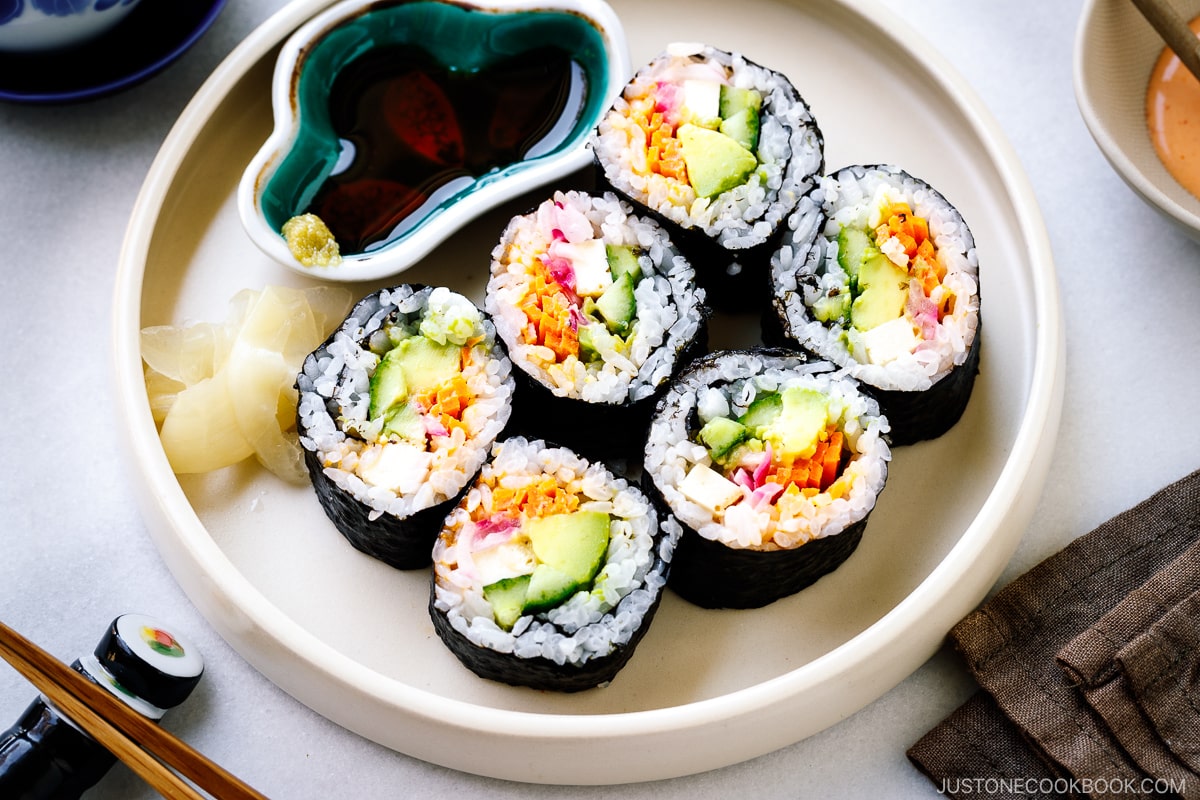
How to Measure Rice: Overfill a ¾ cup measuring cup or a plastic rice cooker cup with uncooked short-grain white rice and level it off. Put the measured rice in a large bowl. Repeat until you have the amount you need. Tip: You must use Japanese short-grain white rice or your sushi will fall apart.

Now, gather all the ingredients.

To Wash the Rice
Quick Rinse: Add just enough water to the bowl to submerge the rice, then pour off the water immediately. Tip: Rice absorbs water very quickly when you start rinsing, so discarding this water right away helps rinse off impurities while keeping the rice from absorbing the first few rounds of milky water.

Wash: With your fingers, gently agitate the wet grains in a circular motion for 10–15 seconds. Tip: Using very little water allows the grains to rub against each other and reduces the absorption of impurities.
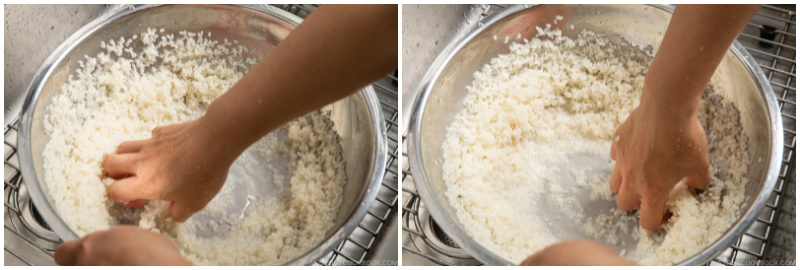
Rinse: Add water and immediately discard the cloudy water.
Repeat Wash and rinse (steps 2 and 3) two more times.

Drain: When the water is almost clear, drain the rice thoroughly. Tip: Use a fine-mesh sieve to drain and shake off any excess water.

To Soak and Cook the Rice
Put the well-drained rice in the inner pot of a rice cooker and add the measured amount of water. If your rice cooker has a Sushi Rice mode, add water up to the line for how many rice cooker cups of rice you're cooking. If not, use the White Rice mode and add water to just under that line. Tip: Use 1 part rice to 1 part water for sushi rice—less liquid than for regular steamed rice—to account for absorbing the seasoned sushi vinegar later.

Check the piece of kombu for dirt particles. If you see any, use a damp cloth to gently wipe them off (this is the traditional method, but kombu is fairly clean these days). Do not wipe off the white powdery substance that contributes to the umami flavor, and NEVER wash kombu! Now, place the kombu on top of the rice in the pot.
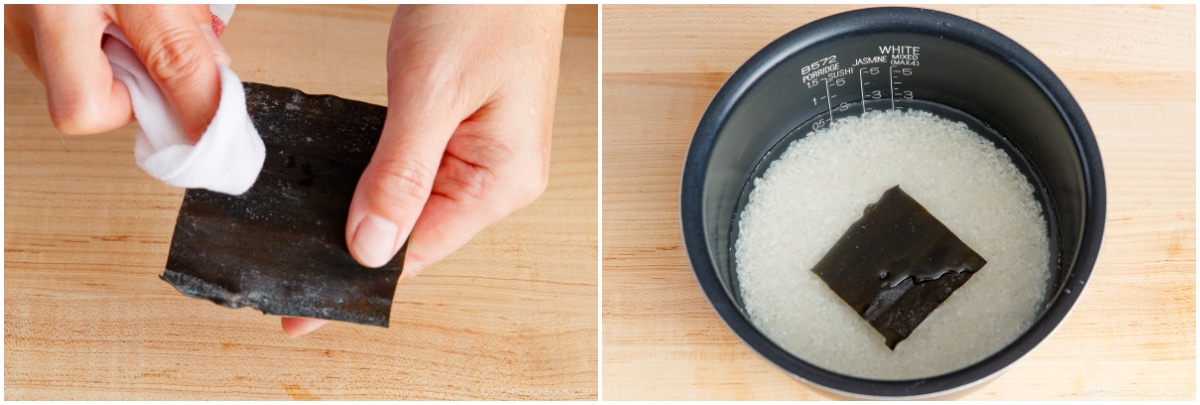
Let the rice soak in the water for 20–30 minutes, then start cooking. If you don‘t have a rice cooker, cook the rice in a pot over the stove, Instant Pot, or donabe with the same amount of water I specified in this recipe.

To Make the Homemade Sushi Vinegar (Optional)
If you are not using store-bought sushi vinegar (seasoned rice vinegar), follow this step. Combine the rice vinegar, sugar, and salt in a small saucepan.

Heat it over medium-high heat until it's nearly simmering, whisking until the sugar is dissolved. Alternatively, you can heat the ingredients in a microwave-safe bowl for 1 minute or until the sugar dissolves. Set aside to let it cool.

To Season the Rice
Moisten a wooden sushi oke (called hangiri) with running water, drain, and dry it with a clean towel. You can also use a large salad bowl or baking sheet lined with parchment paper. Tip: This wooden tub helps absorb excess moisture whereas a ceramic bowl cannot.

When the rice is done cooking, discard the used kombu (or repurpose it to make simmered kombu).

Transfer the hot cooked rice to the sushi oke. Spread out the rice evenly so it will cool faster.

While the rice is hot, pour the sushi vinegar over it.
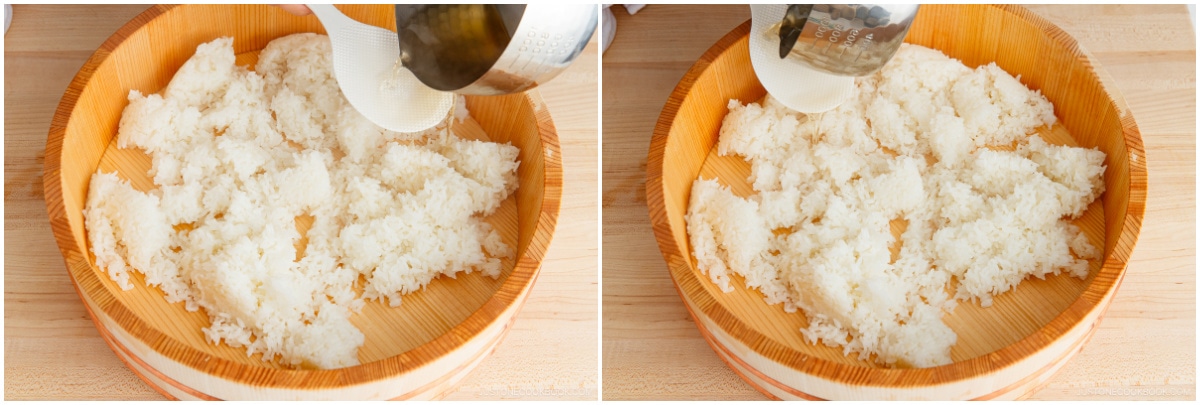
With a rice paddle, gently “slice” the rice at a 45-degree angle to incorporate the vinegar mixture and separate the rice chunks. Do not use a stirring or mixing motion because the grains may break and make the rice mushy. At the same time, vigorously fan the rice with a paddle fan or another type of fan to cool it. Fanning wicks away the excess moisture and makes the rice shine.

Gently flip the rice after every few slices.

Repeat this process until the rice is cooled to the temperature of human skin. Your sushi rice is now ready to use in your favorite sushi recipes.

To Keep
Cover the sushi rice with a damp towel (or paper towel) and keep it at room temperature for up to a few hours. To store it longer, see below.

To Store
Rice gets hard and dry in the refrigerator from the cold air. Therefore, I recommend freezing the leftover sushi rice in an airtight container for up to a month. When you're ready to use it, defrost the frozen rice overnight in the fridge, then bring it to room temperature (not hot) in the microwave. If you really want to refrigerate it, cover the container with a thick kitchen towel, so the rice will stay cool but not become cold.
How Much Rice Do I Need to Cook?
The plastic rice cooker cup that comes with the rice cooker is ¾ cup (180 ml). In Japan, this amount is called ichi go (一合).
- 1 rice cooker cup (180 ml, ¾ cup, 150 g) of uncooked rice makes 2¼ cups (330 g) of cooked rice.
- 1 thick sushi rolls
- 2 medium sushi rolls
- 4 thin sushi rolls
- 3 inside-out rolls
- 2 rice cooker cups (360 ml, 1½ cups, 300 g) of uncooked rice make 4⅓ cups (660 g) of cooked rice.
- 2 thick sushi rolls
- 4 medium sushi rolls
- 8 thin sushi rolls
- 6 inside-out sushi rolls
- 3 rice cooker cups (540 ml, 2¼ cups, 450 g) of uncooked rice make 6⅔ cups (990 g) of cooked rice.
- 4 thick sushi rolls
- 6 medium sushi rolls
- 12 thin sushi rolls
- 9 inside-out sushi rolls
- 4 rice cooker cups (720 ml, 3 cups, 600 g) of uncooked rice make 8¾ cups (1320 g) of cooked rice.
- 5 thick sushi rolls
- 8 medium sushi rolls
- 16 thin sushi rolls
- 12 inside-out sushi rolls
- 5 rice cooker cups (900 ml, 3¾ cups, 750 g) of uncooked rice make 11 cups (1650 g) of cooked rice.
- 6 thick sushi rolls
- 11 medium sushi rolls
- 20 thin sushi rolls
- 15 inside-out sushi rolls
Helpful Notes to Remember:
- One thick sushi roll (Futomaki) requires 1⅔ cups (250 g) of sushi rice.
- One medium sushi roll (Chumaki), like Vegetarian Sushi Roll, requires 1 cup (150 g) of sushi rice.
- One thin sushi roll (Hosomaki) requires ½ cup (80 g) of sushi rice.
- One inside-out sushi roll (Uramaki), like California Roll, requires ¾ cup (110 g) of sushi rice.
- One nigiri sushi requires 20 g of sushi rice.
Calories: 353 kcal · Carbohydrates: 79 g · Protein: 6 g · Fat: 1 g · Saturated Fat: 1 g · Polyunsaturated Fat: 1 g · Monounsaturated Fat: 1 g · Sodium: 344 mg · Potassium: 75 mg · Fiber: 3 g · Sugar: 7 g · Calcium: 20 mg · Iron: 4 mg
Author: Namiko Hirasawa Chen
Course: Side Dish
Cuisine: Japanese
Keyword: japanese rice, rice, sushi
©JustOneCookbook.com Content and photographs are copyright protected. Sharing of this recipe is both encouraged and appreciated. Copying and/or pasting full recipes to any website or social media is strictly prohibited. Please view my photo use policy here.
If you made this recipe, snap a pic and hashtag it #justonecookbook! We love to see your creations on Instagram @justonecookbook!
Editor’s Note: This post was originally published on Aug 18, 2011. It was republished with new images, a new video, and more helpful content on January 19, 2024.











 English (US) ·
English (US) ·